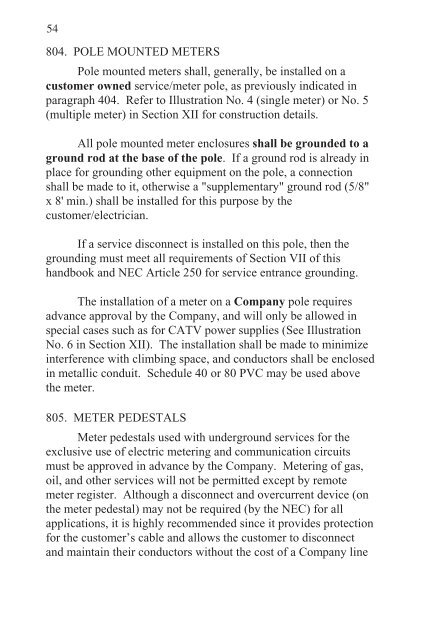HANDBOOK REQUIREMENTS - Central Maine Power Company
HANDBOOK REQUIREMENTS - Central Maine Power Company
HANDBOOK REQUIREMENTS - Central Maine Power Company
Create successful ePaper yourself
Turn your PDF publications into a flip-book with our unique Google optimized e-Paper software.
54<br />
54<br />
804. POLE MOUNTED METERS<br />
Pole mounted meters shall, generally, be installed on a<br />
customer owned service/meter pole, as previously indicated in<br />
paragraph 404. Refer to Illustration No. 4 (single meter) or No. 5<br />
(multiple meter) in Section XII for construction details.<br />
All pole mounted meter enclosures shall be grounded to a<br />
ground<br />
rod at the base<br />
of the pole. If a ground rod is already in<br />
place for grounding other equipment on the pole, a connection<br />
shall be made to it, otherwise a "supplementary" ground rod (5/8"<br />
x 8' min.) shall be installed for this purpose by the<br />
customer/electrician.<br />
If a service disconnect is installed on this pole, then the<br />
grounding must meet all requirements of Section VII of this<br />
handbook and NEC Article 250 for service entrance grounding.<br />
The installation of a meter on a <strong>Company</strong> pole requires<br />
advance approval by the <strong>Company</strong>, and will only be allowed in<br />
special cases such as for CATV power supplies (See Illustration<br />
No. 6 in Section XII). The installation shall be made to minimize<br />
interference with climbing space, and conductors shall be enclosed<br />
in metallic conduit. Schedule 40 or 80 PVC may be used above<br />
the meter.<br />
805. METER<br />
PEDESTALS<br />
Meter pedestals used with underg round services for the<br />
exclusive use of electric metering and communication circuits<br />
must be approved in advance by the <strong>Company</strong>. Metering of gas,<br />
oil, and other services<br />
will not be permitted except by remote<br />
meter register. Although a disconnect<br />
and overcurrent device (on<br />
the meter pedestal)<br />
may not be required (by the NEC) for all<br />
applications, it is highly recommended since it provides protection<br />
for the customer’s cable and allows the customer<br />
to disconnect<br />
and maintain their conductors without the cost of a <strong>Company</strong><br />
line



